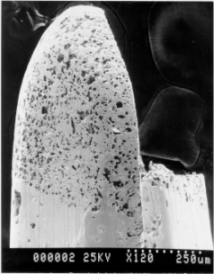

The
pumice stone texture on this ca. 1918 Sheaffer's broken tip
is probably the result of corrosion. This nib would not have
written as smoothly as most made today. 120x enlargement.
My
technical accomplice, Kurt Montgomery and I have laid to rest
the idea that fountain pens are tipped with iridium. No nib
manufacturer that we have found is using iridium for the tipping
of fountain pens anymore. And in fact, they have not been
doing so for decades. But as I disabuse myself of the idea
that these things are made of iridium, a new problem arises.
What will we call this stuff? It is always easy to have a
simple name for a part of something; and iridium, named for
the rainbow, has enough of a mystique around it to be an attractive
choice. But, iridium also is the name of an element, like
oxygen and iron. It is distinct in its meaning just the way
that oxygen is distinct from air, and iron is distinct from
steel. These may seem like trivial differences to the untechnical
mind; but western civilization, through its technology, rides
on these sorts of distinctions.
Iridium
with its melting point of 2,410° C, is one of several metals
in the platinum group that share the qualities of extreme
hardness and corrosion resistance. The others are osmium,
ruthenium, rhenium, and rhodium. Because iridium is very scarce
it is also very expensive.
The most
recent tipping that we could find with iridium in the alloy
was in a 1952 Parker 51 nib (2.6%). The 1956 tip that we sampled
had no iridium, but was comprised of 100% ruthenium. The 1957
tip was made of 56% ruthenium and 44% rhodium. No nibs that
we sampled had any iridium content after that point. (We looked
at current Montblancs, Parkers, Sheaffers, and even an inexpensive
nib, made in India that was stamped "iridium". (See
electron microscope photograph) None of them contains iridium.
I can
only conclude that the word has undergone a transformation
in the same way that xerox has become a copy, and a fridge
is a place to keep food cool and, therefore, something other
than a brand name.
I do not
believe there is a conspiracy among pen makers to foster ignorance,
but rather a linguistic impediment that none considered worth
while to overcome. If most pen sellers talk about their pen
being tipped with the best quality "iridium", who
would want to say that theirs contains no iridium, but is
composed primarily of ruthenium, tungsten and rhenium (as
is the case with Montblanc). This is too complicated and does
not share the cashé of being the material that came from outer
space and traces the extinction of the dinosaurs. The ad men
would hate it.
Are these
alloys any better or worse than the iridium tips of the teens
and twenties? After examining many of them under my microscope
and a few under an electron microscope, I am convinced that
the newer alloys are certainly more consistent, and probably
of higher quality overall than the rough-and-ready material
of past. (Please see the electron microscope picture of a
broken tip from a #4 Sheaffer's self-filling, ca. 1918.) There
are of course many notable exceptions of old nib tips made
from native iridium, that write beautifully, if not miraculously,
but I probably see more than my share of ones that are flawed
for one reason or another.
Over the
course of more than 100 years of nib making, manufacturers
have slowly phased out iridium. Today, it does not seem to
be in use at all. The only residue is the in the name.
When we
compare current Sheaffer, Parker, and MontBlanc tipping materials,
even though they are being used for the same job, they are
all quite different. Based on the range of materials in use
today and the varying composition of the tips, the search
for perfection is still underway.
As for
myself, I can no longer talk about putting new iridium on
the tips of fountain pens. I am still searching for the best
sounding phrase to replace the words, "tipped with iridium."

This nib
is stamped "iridium" on the top surface. It is in
current production and can be found in relatively inexpensive
fountain pens. Kurt and I believe the tip is formed simply
by melting back the body of the nib. Strong evidence for this
speculation comes from analysis of the composition of the
tipping. It is made of 400 series stainless steel. There is
no iridium here, Not even a pellet of hard surface tipping.
©
1999 John Mottishaw No reproduction or distribution without
permission. first
published in The
PENnant Vol.
XIII, No. 3
|


